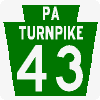
Mon-Fayette Expressway

Mon-Fayette Expressway
This highway has been a long time in coming, and it is still coming. Local politicians hailed the new Mon Valley Expressway as a much needed vital link to Pittsburgh which would supplement rail and river links for the area industries. The original plan also included an expressway to Monroeville referred to as the "New 48" as this highway was to replace the existing PA 48. Into the 1980s, maps of Pittsburgh showed this road as being proposed along side the current PA 48. It would have begun at the Parkway East in Monroeville and then followed PA 48 to PA 51, south of where PA Turnpike 43 connects. When the current plan was proposed, PennDOT and the PTC decided to bring it into Pittsburgh and compensate Monroeville with a spur.
Right of way was cleared including the amusement park that my mother used to go to as a child, Rainbow Gardens in White Oak. Now it is a shopping center called Oak Park Mall and nearly every time we drive past she says, "That used to be my amusement park. They tore down my park to build a road!" Even if she did not know it, mom was a young NIMBYer. I feel a sense of sadness when she says that, because it ended up being destroyed for nothing.
Construction kicked off with a groundbreaking on February 22, 1973, attended by Governor Milton Shapp and Department of Transportation Secretary Jacob G. Kassab and joined by other government officials, which was held in West Pike Run Township along US 40. The $5.9 million project included construction of 1.3 miles of highway encompassing a new bridge to carry US 40 over the expressway, one-half of the full cloverleaf, and four lanes of divided, limited-access highway. The interchange construction finished in 1977.
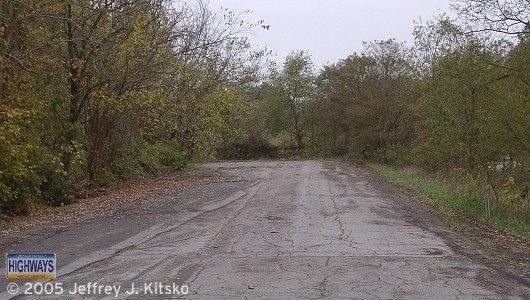
A section of PA 88 at the Low Hill Road intersection that was abandoned
when the expressway was completed in 1977.
Tom Lyons, an assistant engineer for PennDOT District 12, estimated that it would be five more years until all sections from I-70 to Centerville Borough would be under contract. Other sections up to the Allegheny County line, although planned, would likely not get built until the 1980s. The cost of the entire route through Washington County was estimated as high as $250 million, depending on final location and inflationary factors.
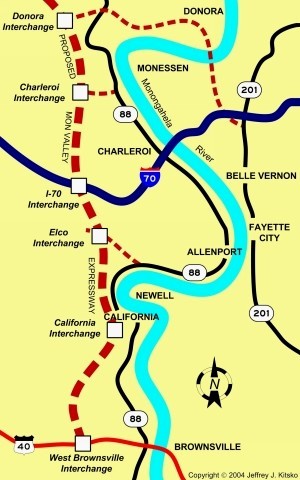
First sections planned to see
construction.
It was still not decided on what would happen once it reached Allegheny County. Originally it was to link up with the South Hills Expressway, then later plans called for its connection to the Oakland Crosstown Freeway. "Our first estimate for the five sections of the Mon Valley Expressway from near the Route 40 interchange to I-70 was $22 million," Lyons said. "As of last November, the estimate was $47 million." A possible relocation of the Interstate was planned, which led to delays in planning two sections. "We can't go into final design until we know what will happen to I-70," District 12 Deputy Engineer Harold N. Harper said. "Then there's always the question of getting projects put into the state capital budget." The federal government agreed to pay for the expressway on a matching 50-50 fund basis. However, PennDOT District 12 tried to shift financing to another program, whereby the federal government would pay 70% of the cost and the wait for the expressway would be shortened. However, due to limited state revenue, the construction program ended. Only the cloverleaf at US 40 and a short section of expressway from Exit 32 to 34 would be built, as PennDOT hit financial straights in the late 1970s and cancelled funding on highway expansion. Construction on most of the Pittsburgh and Philadelphia expressway systems, and I-78 around Allentown and Bethlehem, was put on hold if not outright cancelled.
The savior of the expressway would come in 1985 in the form of the Act 61 legislation, which was the Turnpike Organization, Expansion, and Toll Road Conversion Act, that was enacted and funded completion of the non-connecting sections. On March 26, 1987, then Governor Robert P. Casey committed $40 million to resume construction on the renamed Mon-Fayette Expressway between US 40 and I-70. The name changed to better reflect the areas to be connected by this highway. Casey announced an accelerated design and construction schedule that was to finish the expressway by the mid-1990s. After breaking ground that day on another seemingly dead expressway, Parkway North, he visited my alma mater California University of Pennsylvania to pledge continued support from his administration to the project. "I have made a commitment that my administration will do everything possible to revitalize the Mon Valley," Casey said. He added, "Rather than wait for another study to determine the corridor's feasibility as a toll road, I have decided to proceed with a portion of the long-planned expressway that is possible now to improve this area's access to other major commercial routes." We have to analyze our funding options before deciding on the appropriate funding mix for building various sections of the expressway," he told state, county, and local officials. "But whatever decision is made, we intend to complete these two projects." Upon hearing the announcement, Washington County Commissioner Frank R. Mascara said, "This is excellent news. I think the governor recognizes that the long-term solution for developing the Mon Valley is good highways."
The elation from local officials was not just over getting a highway completed, but also viewing the expressway as an economic shot in the arm for their constituents. The area's major economic base had been the coal and steel industries, but beginning in the 1960s, they started to slowly collapse. By the 1980s, steel mills all along the Monongahela River were shutting their gates and laying off workers. Pittsburgh's economy, even though based in steel, managed to rebound by moving towards high-tech and medical industries with the help of places such as the Pittsburgh Technology Center and the University of Pittsburgh Medical Center. However, the towns of the valley had no infrastructure to base a recovery on, and a highway system that lacked a direct, high-speed connection to other parts of the region and state.
On July 15, 1987, residents along the corridor got to see if three proposed routes would provide them a faster way to Pittsburgh or threaten their homes. The Pennsylvania Turnpike Commission's first public meeting was held at the Belle Vernon Holiday Inn, where people could view maps of the proposed routes as well as submit their comments. The three corridors, all following the same general path in Washington County but diverging near Clairton, were named green, yellow, and orange.
Turnpike Commission design liaison engineer said, "We've come to the public to show them what we've come up with and to solicit their opinions and suggestions, along with [those of] public officials." He added, "We have an idea that's it's generally wanted, but now we have to decide where it's going to go, to refine it." The 18-month corridor study, at the time only one-third completed, would be followed by an 18-month design location study where five possible specific routes inside one of the three mile-wide corridors would be examined. One route would eventually be recommend.
Most politicians welcomed the expressway, except for one. Pittsburgh Mayor Richard Caliguiri opposed the Green Corridor because it "appears to significantly disrupt the Lincoln Place, Hays, New Homestead, Greenfield, and Hazelwood neighborhoods." He made his feelings heard in an October 9, 1987 letter to James B. Wilson, chief engineer of the Turnpike Commission, by saying, "Over the years, the city of Pittsburgh has given up a number of its neighborhoods to highway links serving suburban and regional areas." He added, "Unfortunately, these neighborhoods are never replaced or enhanced by the projects. I cannot continue to allow that pattern to continue, particularly when there are other ways to achieve the desired transportation improvements." Caliguiri supported upgrading PA 837, which parallels the Monongahela River and traverses a number of former steel mill sites including Homestead, Munhall, Clairton, and West Elizabeth.
Not only was the mayor against the proposed corridor, but so were the residents of the neighborhoods in the path. More than 100 people attended a City Council hearing on November 19, 1987 to oppose the Green Corridor, which residents said would ravage Hays, Lincoln Place, Hazelwood, and Greenfield the same way the East Street Valley Expressway did to a part of the North Side. "We can't forget the East Street Valley and the displacement it caused of Pittsburghers, " said Councilman-elect Michael Coyne. "We cannot allow another such displacement." Mark Zabierek, an aide to Mayor Caliguiri said, "It's important to understand how dangerous the Green Corridor would be to the city. The mayor is unalterably opposed to it." Gary Lachappell, president of the 31st Ward Citizens Council said, "The 31st Ward is dead set against the Green Corridor. The people of our neighborhood would be devastated." One of those residents in the path, Debbie Navilliat of Lincoln Place, said, "I would look out my dining room window and see a turnpike. Who wants to do that?" To show support of both the expressway and the neighborhoods, Turnpike Commission Vice Chairman James Dodaro, said at the hearing, "There is a need for the expressway to serve as an economic development catalyst for the Mon Valley, but we don't want massive disruption of communities."
With growing resentment towards the expressway, the PTC began to study the feasibility of building part underground to avoid disrupting the neighborhoods in the path. The tunnel would begin in the vicinity of the Allegheny County Airport in West Mifflin and end at the Glenwood Bridge. It would be about the same length as the one-mile long Fort Pitt Tunnel, said Turnpike Executive Director Louis Martin. At the bridge, a Y-shaped interchange would provide drivers a choice of going west on the Parkway to Pittsburgh or east to Monroeville. Each leg would connect on different sides of the Squirrel Hill Tunnel, and provide commuters with a bypass of the often-clogged tunnel with a toll for the privilege. Martin said that there was no estimate of the cost of the tunnel's construction. Originally, the expressway was to meet the Parkway at one point, but it would have created an excess of vehicles adding to congestion at the Squirrel Hill Tunnel, regardless of which side was chosen as the connection.
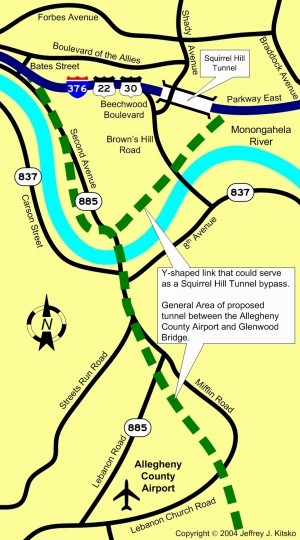
Location of the proposed tunnel.
On November 23, 1987, another public meeting was held at the Howard Johnson's Motor Lodge in Monroeville to show residents to now four possible corridors with only a dozen people attending. This contrasted with the more than 100 people who showed up at the City Council meeting the week before. The alternatives presented at this meeting were:
The corridor sections through Fayette and Washington Counties, uncontested by residents, was selected in January 1988. The controversial section from I-70 to the Parkway would likely take until the end of 1988. Edward Cyr of West Mifflin, an attendee of the meeting, said "If it will add jobs around the community...get some people working, it would be good." He admitted, though, that "if it was taking my house I don't think I'd be too happy." Ivan Livi, president of the Pittsburgh Institute of Aeronautics, said he attended to find out how the Green Corridor would affect the county airport where his school is located. "I'm concerned about what will happen. The school has been here for 60 years and now all of a sudden, we're looking at [possibly] moving it," he said. Timothy Smith, a PTC design engineer said the expressway would probably not go through the airport property unless the county granted a right-of-way. Joe Gibbons of Penn Hills, who came to see how his tavern in Glenwood would be affected, said, "Anything that would bring people in would be good for me." Although he added, "If they get people in the area to build it, fine. If they're going to get somebody from out of state to do it they might as well scrap it."
On January 27, 1988, regional planners announced a alternate location for the expressway along the northern shore of the Monongahela River to alleviate the controversy of the Green Corridor which planned to plow through populous city neighborhoods. The "Mon Valley/Route 837 connector" would be a seven-mile, four-lane limited access highway stretching from the Glenwood Bridge to the PA 885 interchange of the Parkway. The $88.9 million alternate alignment would bypass Greenfield, Hazelwood, and Lincoln Place. Residents angrily denounced the plans a year earlier on the grounds it would uproot their neighborhoods. James Dodaro, county solicitor and a Pennsylvania Turnpike commissioner, said, "We are very sensitive to city residents as it relates to neighborhood disruptions and uprooting families." He said the commission "wants to develop an expressway plan that is doable in the near future. We don't want pie-in-the-sky plans that will run into too many roadblocks and won't make the project feasible." He mentioned that south of the Glenwood Bridge, the PA 837 expressway corridor would follow undeveloped railroad property through Homestead, Duquesne, McKeesport, and Clairton, all of which are in need dire need of economic redevelopment.
On June 9, 1988, Governor Casey broke ground to continue construction on the section between US 40 and Interstate 70. This project would mark the first contract under construction in the corridor in 12 years!
A 45-minute-long ribbon-cutting ceremony was held on October 12, 1990 with local and state dignitaries in attendance. "Let the quarters flow," exclaimed state Senator J. Barry Stout as Governor Casey was driven through the California Toll Plaza. The highway was one of his promises when he ran for governor in 1986. "I wanted to make a statement about who I was and what my priorities were," he said. "That statement was that the days were gone when people of southwestern Pennsylvania would be written off by state government." The governor called the Mon-Fayette Expressway the "number one highway project" in the state.
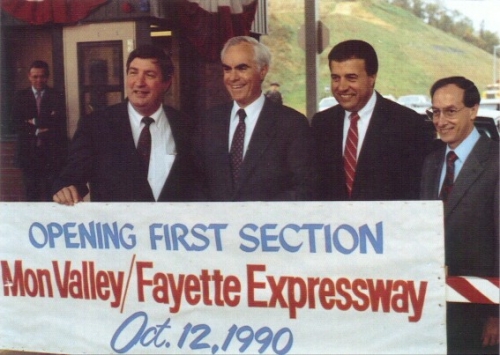
L-R: Senator J. Barry Stout, Governor
Robert P. Casey,
Commissioner
James J. Dodaro and Chairman Howard
Yerusalim at the opening.
(Pennsylvania Turnpike Commission)
While the politicians were focused on the pomp and circumstance, local residents, such as Mary Ann Quinn from Low Hill near the southern end of the section, were thinking more down-to-earth. "I was in junior high school when they started it," she said before the ceremony had started. "I'm sure my boys will be in their 20s, if they're even around here, when the rest of it is finished." Her sons Julian and Jonathan were off from school that day and accompanied her to the opening. "Truthfully, I don't think a lot of people are as excited about this as the politicians," Mrs. Quinn said. "It only gives the younger generation a quicker way to get out of the valley."
"We don't see a lot of young people here because we've lost jobs and opportunity," said state Representative Pete Daley. "We want to give them the hope to know they can come back to this valley. This road symbolizes that hope."
While Turnpike Commission personnel would man the mainline toll plaza, maintenance was contracted out to PennDOT due to how isolated the section was from the Turnpike. Teamsters Local 250, whose members, maintain the Turnpike itself, had been critical of this plan. There had been rumors that some might show up at the ceremony to demonstrated did not. Three hours after the ceremony, the finally completed $55.3 million section was opened to traffic.
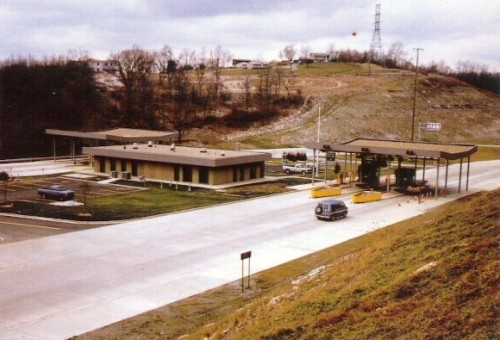
California Toll Plaza (Pennsylvania Turnpike
Commission)
With time and then traffic putting wear and tear on the expressway, the surface was beginning to wear at the start of the 21st Century. The PTC spent $6 million to resurface the northbound and southbound lanes between Exit 32 and the California Toll Plaza.
Support for this road was bipartisan with funds coming from both Democratic and Republican officials. Governor Richard Thornburgh authorized PennDOT to build the interchange with I-70. Governor Robert Casey helped to make the I-70 to US 40 section complete. The late Senator John Heinz pushed a bill through Congress to authorize the construction of toll roads with federal funds and Representative Austin Murphy secured funds for the Chadville Demonstration Project south of Uniontown.
The next section, the Mason-Dixon Link, to be opened was from the end of the Chadville Demonstration Project to the Gans Road Exit. Environmental clearance was granted by the Federal Highway Administration on September 23, 1994 with the groundbreaking ceremony taking place on November 1, 1994. The opening occurred on March 1, 2000 at 10 AM and was attended by the Governor Tom Ridge of Pennsylvania and Governor Underwood of West Virginia. West Virginia Department of Transportation's Division of Highways awarded its first contract in October 1999. The section from the West Virginia state line to Exit 2 would sit idle for a little more than 11 years until the ribbon-cutting ceremony on July 11, 2011 that was held just north of the Mason-Dixon Line just after West Virginia held their ceremony.
 Construction
on the Chadville Demonstration Project, from the Morgantown Road interchange to
the US 40 east interchange, began with a groundbreaking ceremony which Governor
Robert Casey was in attendance for on October 22, 1990. It was built under
the direction of PennDOT and handed over to the Turnpike Commission when it
opened in 1993 and is the only section of the highway to be designated PA
43. Originally, this section was planned as a two-lane
expressway on a four-lane right-of-way. The reason was that the Turnpike
Commission wanted to start construction in 1990, but did not have the money to
pay the $30 million price tag which was a far cry from the original estimate of
$11 million. PennDOT Secretary Howard Yerusalim said, "It won't be a
two-lane road for long. By 1992, we will have the funding in place to
build the other two lanes. We're fully committed to the expressway
project." This plan created dissent among Fayette County
officials. "A piecemeal approach will not work," said Andy
Juracko, district administrator for United States Representative Austin J.
Murphy of Monongahela. "Such action indicates our inability to
deal with the economic conditions of our area." Construction
on the Chadville Demonstration Project, from the Morgantown Road interchange to
the US 40 east interchange, began with a groundbreaking ceremony which Governor
Robert Casey was in attendance for on October 22, 1990. It was built under
the direction of PennDOT and handed over to the Turnpike Commission when it
opened in 1993 and is the only section of the highway to be designated PA
43. Originally, this section was planned as a two-lane
expressway on a four-lane right-of-way. The reason was that the Turnpike
Commission wanted to start construction in 1990, but did not have the money to
pay the $30 million price tag which was a far cry from the original estimate of
$11 million. PennDOT Secretary Howard Yerusalim said, "It won't be a
two-lane road for long. By 1992, we will have the funding in place to
build the other two lanes. We're fully committed to the expressway
project." This plan created dissent among Fayette County
officials. "A piecemeal approach will not work," said Andy
Juracko, district administrator for United States Representative Austin J.
Murphy of Monongahela. "Such action indicates our inability to
deal with the economic conditions of our area."
|
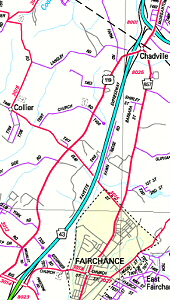
|
This section featured a state-of-the-art toll collection system using dual height multi-mode machines to accommodate both cars and trucks. The toll collection equipment accepted coins, $1 and $5 bills, and PTC credit cards. Also a new solar powered cellular call box system that will allow real time voice communication with a radio operator was installed. It is so sophisticated that even if the caller does not say anything, the location can still be found. The system was different from the one employed on the other sections of PA Turnpike 43 and the Turnpike System at the time in that the others just use four buttons to summon help: service, police, medical, and accident. The total costs for this 3.5-mile-long section are estimated at $150 million: $11 million for engineering and environmental clearance, $17 million for final design, $7 million for right of way acquisition, $3 million for utility relocations, $96 million for construction, and $11 million for construction management.
During the construction of this section, problems arose due to blasting which caused cracks to appear in local homes. Officials from the Turnpike Commission had said that there were two seismographs used to gauge the blasts. To address the problem, the commission started town meetings to hear and respond to citizens' complaints.
On October 17, 1999, a "Community Day on the Expressway" was held that featured food booths, bands, and collector cars. It was an open house for the highway, which a similar event happened when the initial section of PA Turnpike 66 opened.
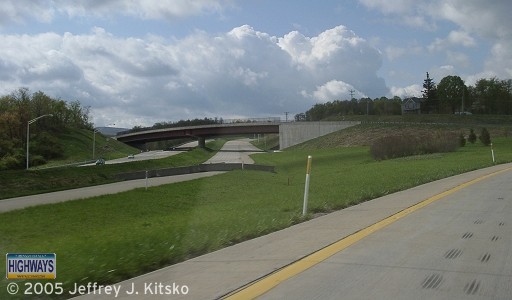 View from the Exit 2 off-ramp onto the closed section of PA Turnpike 43. |
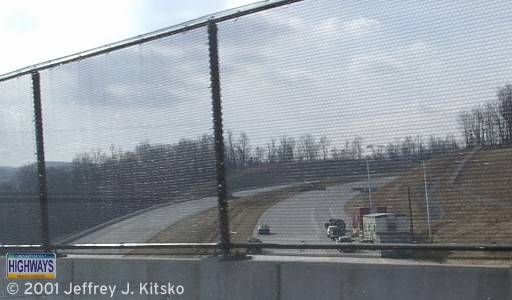 Close-up view of the remainder of the highway as it heads to West Virginia. |
The Federal Highway Administration released its Record of Decision on May 19, 1994 for the Interstate 70 to PA 51 section with construction beginning in 1995. Unfortunately, this section was host to two tragic events in 1999. In August, a worker fell off a backhoe and was crushed to death by the piece of equipment. On September 2, another worker helping to move a house in the future alignment was crushed to death when the house collapsed in transit.
Governor Tom Ridge signed a bill into law on June 13, 2001, giving names to different highways and highway related structures around the state. This section from I-70 to the Allegheny County line received the name J. Barry Stout Expressway after the senator who pushed to expand the state's highway system which included the Mon-Fayette Expressway and Southern Beltway. He and the late state representative James Manderino served on the committee that helped to shape Act 61, which is the legislation that got construction started again on the long abandoned corridor.
As the highway inched closer to more populated surroundings, the people in West Mifflin became more concerned. A meeting was held to determine the route through the borough, which is an area that is very built-up with strip shopping centers and Century III Mall, the fourth largest shopping complex in America. The meeting was with borough officials, Pennsylvania Turnpike officials, and the public. Maps were published to show the proposed route and Turnpike officials said that almost 200 parcels of land would have to be purchased for the highway. They were trying to lay the road so that no houses are effected, however, four had to be moved.
The PTC decided to open a section of the Interstate 70 to PA 51 stretch a little early. On May 11, 2001 at 11:00 AM, the barricades closing off the section from I-70 to Coyle Curtain Road came down which allowed the local residents to utilize this complete three-mile section. I was one of the first people to travel it the day it opened.
As has happened on the Mason-Dixon Link, a "Community Day on the Expressway" was held on April 7, 2002. Folks were invited to walk, bicycle, or skate down the new highway. Also, free bus tours were offered of the 13 then unopened miles. The remaining part of $588 million section opened on April 12, 2002 with the ribbon-cutting at 3 PM. The day's events had a military theme which included special recognition of 13 Medal of Honor recipients from the corridor between Pittsburgh and West Virginia. This section is home to a new design in toll plazas. The Jefferson Hills toll plaza just south of PA 51 is designed much like the ones seen on Oklahoma's toll highways, with the toll booths off to the right while vehicles with E-ZPass will be allowed to continue at highway speed on the through lanes. For those paying with cash, you will find no attendants. The toll machines are like the ones found at the Fairchance Toll Plaza, with dual height multi-mode machines to accommodate both cars and trucks and accepts coins, $1, and $5 bills. While this high-speed E-ZPass toll plaza was the first one in the Turnpike System, it was one of the last to open to traffic which occurred at 10 AM on June 7, 2010.
This completed section resulted in changes to an older section. A new fare schedule was implemented at the California Toll Plaza the same day as the Exit 39 to PA 51 section opened. The fare increases were as follows: Class 1 fare is 75 cents, up from 50 cents; Class 2 is $1.50, up from $1; Class 3 is $2.25, up from $1.50; Class 4 is $3, up from $2; and Class 5 is $3.75, up from $2.50. This was the first adjustment of fares since that section opened in 1990.
On June 13, 2002, flash flooding caused extensive damage to homes and businesses along former PA 71 adjacent to Maple Creek. Crossing over the valley are 200-foot high dual bridges that carry PA Turnpike 43 across just north of Exit 36. Residents believe that the presence of the expressway led to the flooding, which happened after two to three inches of rain fell. Representatives of Greenhorne & OíMara, Inc., a consulting firm hired by the Turnpike Commission to study storm water management on this section of PA Turnpike 43, met with officials from the PTC on June 20, 2002.
A familiar name graces the bridges over Mingo Creek and PA 88 in Washington County. The Joe Montana Bridges, named for the former San Francisco 49ers and Kansas City Chiefs quarterback, stand not far from where he played football at Ringgold High School. He visited the expressway on August 17, 2002, during a rare visit to the Monongahela River Valley area where his famed career started for a fundraiser for the local YMCA. Montana got his first view of the highest bridges on the Pennsylvania Turnpike System just north of Exit 44. "I remember walking home and taking that road," Montana told a small crowd of family and friends who gathered at the north end of the bridge that carries the southbound lanes. "It's an honor to be remembered this way." Tom Fox, public information/public involvement manager at the Turnpike's Western Regional Office in New Station said, "Joe couldn't have been nicer. We were appreciative that he took time from an already busy schedule to visit the expressway and see the bridges that serve as a constant reminder of his roots and the inspiration and example he represents for everyone in the mid-Mon Valley."
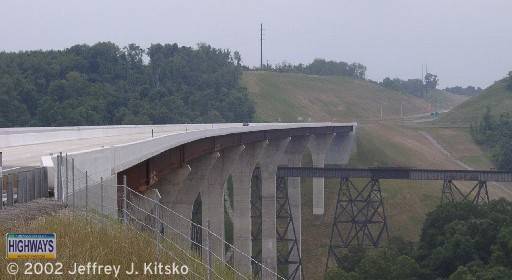
Looking over the side of the Joe Montana Bridges.
This section has earned numerous state and national awards for its excellence in design and construction. The latest honor came in April 2003 at the Associated Pennsylvania Constructors 2003 Spring Conference, and is from the Pennsylvania Partnership for Highway Quality (PPHQ). The PPHQ selected the Interstate 70 to PA 51 segment for its 2002 Project Recognition Award. "These awards show that the Turnpike Commission is receiving state-of-the-art design and construction services from its consultants and contractors, not to mention our own staff professionals who contribute to and monitor this work," said Frank J. Kempf, Jr., assistant chief engineer for development projects/programs. He added, "Building this new transportation infrastructure so vital to our Commonwealth's economic standing is a total team effort. It starts with the state lawmakers who assigned and funded these projects and runs the gamut through the hundreds of technicians, equipment operators and laborers who studied environmental impacts, sought the best solutions, moved the dirt, poured the concrete, set the steel, and bolted the signs. Here are a few more awards:
Thanksgiving travelers got an early present on November 24 when toll collectors and maintenance personnel walked off the job for the first time in 64 years at 4 AM, forcing the PTC to wave tolls on the busiest day of the year. Teamsters Local 77 and 250 went on strike due to not receiving raises unlike non-union employees. The Commission offered a raise of $21 per hour over three years, fully paid health care package, 15 paid holidays, an average of four weeks of vacation a year, and a no-layoff clause for three years. The union rejected the offer, but would not comment on the reason. Due to this strike, no tolls were collected on PA Turnpike 43. A tentative agreement was reached through negotiating sessions that began November 29 at 2:30 PM and ended on November 30 around 10 PM, ending the seven day strike. Tolls were reinstated at 9 AM on December 1, 2004.
Mine subsidence has troubled a section near milepost 43 since it opened, which prompted repairs to be made in May 2006. The cost of the work was $470,000 which included removing the pavement, raising the grade, resurfacing, adjusting drain inlets, replacing the guiderails, and regrading the median near the PA 136 interchange. The problem was getting so bad that vehicles traveling at 65 MPH could feel noticeable roughness, even worse for those driving trucks. However, the problem was foreseen even before traffic began using the section. A 400-foot-long section was removed and replaced with asphalt to compensate for subsidence. Shortly after opening, the PTC spent $100,000 for a geotechnical engineering firm to drill test holes and investigate subsidence on a 150-foot-high embankment which supports part of the expressway. In 2003, $130,000 was spent to repair water erosion under the Joe Montana Bridges and $13,000 to repair subsidence at the bridges' approaches.
On April 1, 2006, a ground breaking ceremony was held off Old Pittsburgh Road near the US 119 and PA 51 interchange in Uniontown. Local and state officials were on hand for the ceremony and ground breaking. The Federal Highway Administration approved the final Environmental Impact Statement for this section of the expressway on October 18, 2000. With that approval, the PTC was able to proceed with final design and right of way acquisitions.
The ground was causing more problems for homeowners in Carroll Township, Washington County in January 2008. Fill that was placed to build a section began sliding into a small valley, affecting homes on Taylor Run Road just off PA 481. Some of the loose soil and trees carried with it landed in the backyard of one of the residences and damaged a deck. A second house was not physically damaged but deemed unsafe because of the continual movement. Fissures were spotted in the ground were tons of material failed near a bridge that carries the expressway over Taylor Run Road, but the structural integrity of PA Turnpike 43 was not impacted. The soil began sliding at 8:30 AM on January 4 and had slowed but was continuing to move when checked at mid-day. The two families affected were moved to hotels temporarily until housing could be found for them, but the Turnpike Commission agreed to buy the two impacted homes.
 The
Turnpike Commission held its traditional "Community
Day on the Expressway" event for Phase I of the Uniontown-to-Brownsville section
on October 11, 2008. The event was done in partnership with the Fayette Chamber
of Commerce, Steps to a Healthier Fayette County, the National Road Heritage
Corridor, and construction manager TCMS-Maguire. The day kicked off with
the Family Fun Walk at 9 AM sponsored by Steps to a Healthier Fayette County
followed by a "Modes of Transportation" parade at 10 AM.
Visitors could walk or bike or take a bus tour of the new alignment. Food
vendors, informational booths, and a children's area were located at Exit 18.
The
Turnpike Commission held its traditional "Community
Day on the Expressway" event for Phase I of the Uniontown-to-Brownsville section
on October 11, 2008. The event was done in partnership with the Fayette Chamber
of Commerce, Steps to a Healthier Fayette County, the National Road Heritage
Corridor, and construction manager TCMS-Maguire. The day kicked off with
the Family Fun Walk at 9 AM sponsored by Steps to a Healthier Fayette County
followed by a "Modes of Transportation" parade at 10 AM.
Visitors could walk or bike or take a bus tour of the new alignment. Food
vendors, informational booths, and a children's area were located at Exit 18.
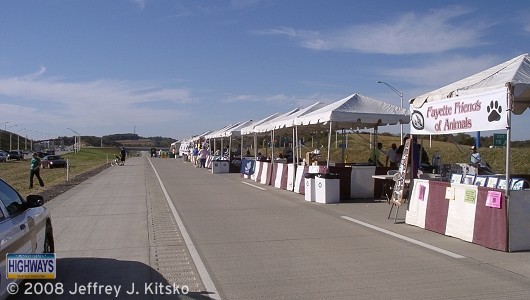 Food vendors, informational booths, and a children's area were provided. |
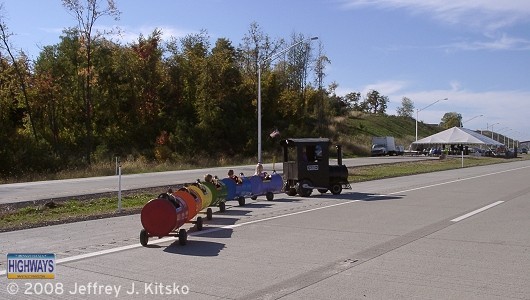 The Rainbow Express trackless train was one of several activities for children. |
Phase 1 of the Brownsville-to-Uniontown section opened to traffic on October 23, 2008 and cost $390 million.
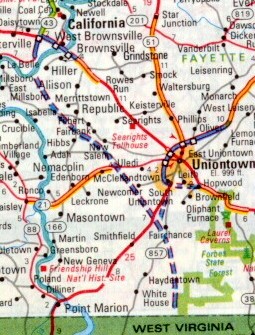 (Rand McNally) |
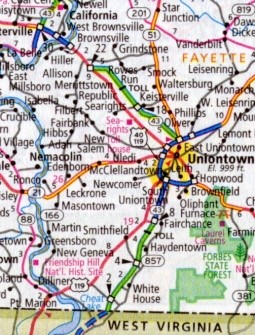 (Rand McNally) |
|
Rand McNally jumped the gun in the
1992 edition of the road atlas by
indicating this section as being under construction. Also, it is indicated as
a free expressway. However, they did get the Chadville Demonstration Project and the US
40 bypass correct.
Compare that to how the area is illustrated in the 2009 edition on the right. |
|
In 1993, state officials said they planned to put this section on hold for at least two decades. A team of public, civic, and business officials, formed under the direction of Governor Robert Casey, presented its studies of this section in Uniontown on April 8. The officials and special consultants hired to help with the studies, used the information gathered for a meeting in Harrisburg on April 15 with Federal and state regulatory agencies to win their approval. It took awhile for the decision to become public, and when it did, it spawned outrage. A meeting was held in Uniontown on December 7, 1992 that attracted 450 people. A week later, the governor ordered PennDOT Secretary Howard Yerusalim to re-evaluate the decision, and since then, 30,000 signatures were gathered pushing for the restoration of the missing link. The decision to give this section lowest priority was reached at a two-day meeting of area decision makers, including lawmakers, planners, and private consultants in June 1992.
Between the two meetings, new traffic studies were made, and plans to make the US 40 corridor a national heritage park were devised. However, what was not studied was whether the completion of the missing link would siphon traffic and tolls from the Pennsylvania Turnpike by creating a shortcut between I-68 and I-70. Since completion in August 1991, some truck traffic that previously used the Turnpike switched to using Interstate 68.
There were many routes being considered for this leg of the highway including: through Brownsville's Northside Historic District utilizing the existing Lane Bane Bridge which would have been widened, and a 1,000-foot "cut and cover" tunnel built under US 40; a southern Brownsville option through Centerville Borough and Luzerne Township; and a northern Brownsville proposal near California. The points of connection to the existing expressway would either be with PA Turnpike 43 near California or PA 88 near Centerville. The southern connection with US 119 at either PA 51 in North Union Township or PA 21 in South Union Township. It was decided that the former would be the point of connection between US 119 and PA Turnpike 43. Construction on the interchange began in June 2008 and consisted of building five new bridges, the tallest being 56 feet, and rehabilitating two existing bridges over US 119. The $72 million interchange opened on a blustery December 13, 2010 at 9 AM that morning.
One thing that politicians like to support are new transportation corridors for their districts and get them as quickly as they can. However, Senator Rick Santorum seemed to feel otherwise. At a February 18, 2000 meeting with several members of the Mon Valley Progress Council, Santorum said that the construction of the Mon-Fayette Expressway from PA 51 to Pittsburgh should be the top priority and that completion of the section of the highway that runs through Fayette County is another matter. While speaking to the group, he said that their Plan H was too ambitious.
Plan H, unveiled in 1999 by MVPC, called for use of $186 million of the additional $400 million in federal funding Pennsylvania received in the Transportation Efficiency Act for the 21st Century, also known as TEA 21. Although TEA 21 runs through 2005, Plan H seeks such funding for 20 years to construct the final two sections of the Mon-Fayette Expressway and the Finley Connector of the Southern Beltway.
Senator Santorum went on to say, "My only concern is you’re asking too much. $186 million for 20 years is too much. You’re three counties out of 67 asking for one-quarter of the (new) revenue." He also mentioned that the PA 51 to Pittsburgh section is the "main artery to the heart." Only after that section is complete can construction of this section "be justified."
Phase 2 consisted of building the US 119/PA 51 interchange as well as eight miles of roadway from Redstone Way to the existing PA 88 expressway in West Brownsville. The cost for this phase is $445 million, and including preliminary engineering, environmental impact studies, and right-of-way acquisition pushed the entire 17-mile section over $882 million. The Turnpike Commission began accepting bids for this section in early 2008 and awarded a $31.3 million contract to Golden Triangle Construction for construction of a 1.5-mile-long section in Redstone Township which entailed building the expressway as well as an overpass to carry US 40 over PA Turnpike 43, and twin bridges crossing Dunlap Creek and Davidson Siding Road. All six roadway construction contracts to complete Phase 2 were awarded between March 18 and August 19, 2008 which totaled a combined $412 million.
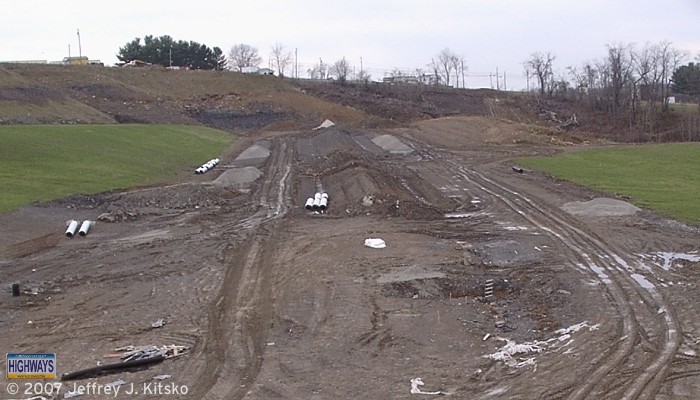 Facing northbound on the future alignment at the US 40 interchange. |
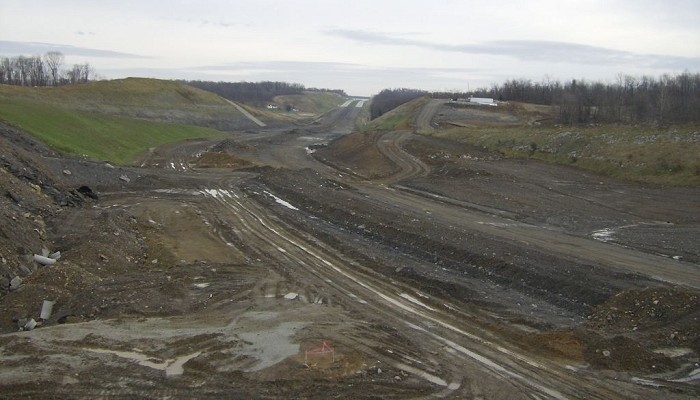 Facing southbound towards Uniontown at the US 40 interchange where you can see a section of completed expressway. (Ed Szuba) |
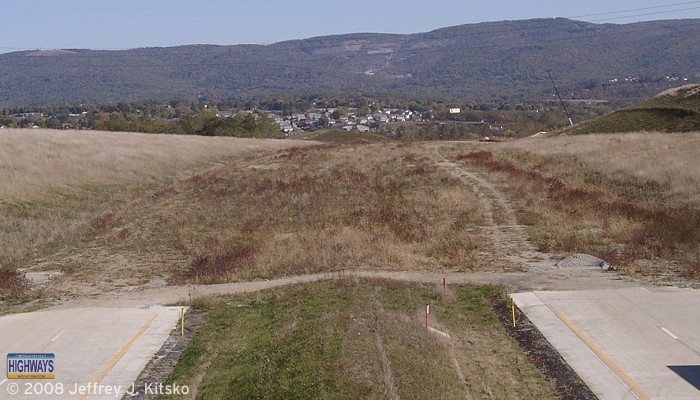 Facing towards the future US 119/PA 51 interchange in Uniontown. A crane working on it can be seen just over the end of the bank at the right. |
US
119/PA 51 Interchange ![]() - Pennsylvania Turnpike Commission
- Pennsylvania Turnpike Commission
Monongahela
River Bridge ![]() - Pennsylvania Turnpike Commission
- Pennsylvania Turnpike Commission
Just days before the opening of Phase One, a worker was killed on October 20 in Luzerne Township on Phase Two. Gilbert Eutsey was cleaning a chipping machine when he was pinned and could not breathe. Co-workers attempted to save his life by performing CPR. The Fayette County Coroner determined the cause of death to be compression asphyxiation. An electrician, Ralph Wayne Greely of Monessen, was killed working in the same section on January 6, 2009. He was working on power lines along Simpson Road when was electrocuted. Greely was breathing following the shock but went into cardiac arrest while being transported to Brownsville Tri-County Hospital which is only a quarter-mile east from the scene of the accident.
In late 2009, inspections on the Monongahela River Bridge revealed inferior sections of the piers. The Turnpike Commission inspects concrete used in piers to make sure it can support 5,500 pounds per square inch, and it was discovered that of the 120 feet of the 150 foot piers that were completed, the top 60 feet did not meet requirements and were needed to be replaced. Walsh Construction of Chicago, the contractor for this segment of the expressway as well as the new Allegheny River Bridge, was ordered to demolish and recast the inferior sections of the piers as well as cover the nearly $500,000 cost of the work. This is the first time there has been a problem on the project with concrete not meeting specifications, but the problem did not delay opening of this eight mile section which took place July 16, 2012. The official ribbon-cutting ceremony for Phase Two was held August 2, 2012 on the Monongahela River bridge with Governor Corbett, elected officials, and other dignitaries in attendance. "This bridge we stand by today represents a major engineering and construction achievement, but it means something much more to the citizens of the Mon Valley," Governor Corbett noted. "It represents renewed hope and opportunity for the people in an area where coal and steel once dominated -- people looking for a brighter tomorrow for themselves and for their families." State Senator Peter Daley urged Governor Tom Corbett and the Turnpike Commission in December 2011 to open as much of the bypass around Brownsville as possible, but his request fell on deaf ears. The Uniontown-to-Brownsville project was divided into 11 construction sections, one Monongahela River Bridge section, a PTC maintenance facility section, and a toll plaza section.
Pryritic rock is a thorn in the sides of PennDOT, but their comrades at the PTC don't seem too concerned. In fact, Mike Houser an engineering project manager with them says, "Basically, it's a good roadway building material." I think PennDOT District 2 would beg to differ. Residents living near the expressway are not that pleased to hear about the fill. However, Dave Cutlip, an environmental monitor on the project says that it is non-acidic but rather more alkaline. Helen Humphreys, of the Pennsylvania Department of Environmental Protection, said the agency is aware of the pyrite in the rock but that runoff in sediment ponds has not tested positive so far.
The expressway was ready for its close-up in the late 2000s as movie directors flocked to it to film highway scenes. A seven to eight mile section around the Redstone Toll Plaza was closed from October 4 to October 5, 2009 to accommodate shooting of The Next Three Days. For their part, the studio producing the movie, Lions Gate Entertainment Corporation, picked up the $25,000 tab for lost tolls, maintenance and safety, and police and emergency services, for the 24 hours it was closed. Another movie, Love and Other Drugs had scenes that were filmed along the roadway just west of Charleroi.
An usual conveyance made its appearance on the expressway on August 7, 2013. A single-engine plane made an emergency landing in the southbound lanes at the US 40 interchange around 11 AM. The pilot managed to avoid an overhead sign gantry, high-tension power lines, the US 40 overpass and a tractor-trailer and a car. The plane was en route from Rostraver Airport to Waynesburg when it began to experience propeller problems. Motorists who witnessed the landing stopped to check on the two passengers, and even snapped some pictures. California Borough police, volunteer firemen, ambulance crews, and State Police from New Stanton's Troop T barracks responded.
After a long hiatus on construction and planning, things started moving along for the remainder of the route to Monroeville. In late December 2019, it was announced that the PTC had completed purchases of 145 properties and in negotiations on 26 others standing in the way. None had been acquired by eminent domain. Another 85 partial parcels will need to be acquired, but negotiations had not begun with those owners. In all, 256 pieces of property will be needed for the 8-mile, $900 million project. About 30% of the project is in final design and would be constructed from south to north starting at the PA 51 interchange in Jefferson Hills. Full interchanges will be built at Camp Hollow Road, Pittsburgh-McKeesport Boulevard, and PA 837. Duquesne Light Company has begun relocating its facilities in at least three locations along the future alignment, with the PTC reimbursing them $15.9 million so far.
When the Coronavirus, or COVID-19, pandemic swept into the country in March 2020, the PTC took measures to stem the spread to their employees and staff. On March 13, the Turnpike Commission announced that the Valley Forge and King of Prussia service plazas would suspend food service and close their restrooms, replacing them with portable toilets beginning at 3 PM that day due to a viral "hotspot" in Montgomery County. An announcement was also made starting Monday, March 16, all office buildings would be restricted to only those employees with assigned workspace in the building. Guests, other employees, consultants, or contractors without an assigned workspace would not be permitted to enter. Employees who work in multiple buildings would have to designated a single location from where to work. All tours of Turnpike facilities from outside groups would be suspended. By Monday, the Peter J. Camiel Service Plaza was added to the list of those shuttering food service and restroom facilities until March 27 before the decision was made to do the same at the remaining 14 service plazas. The Turnpike Commission also decided to suspend cash and credit card payments that day, and assess tolls electronically via E-ZPass and the PA Turnpike TOLL BY PLATE program. "This temporary measure is critical to enable us to support the Commonwealth in its efforts to mitigate the spread of COVID-19," said PA Turnpike CEO Mark Compton. "I want to be clear that we will return to normal toll-collection operations as soon as it becomes practical." Customers without an E-ZPass account were instructed to continue to use lanes marked "Tickets" on entry and "Cash" on exit. Drivers who receive a TOLL BY PLATE invoice were charged the "cash" toll rate and had 20 days to pay before a second invoice was issued which would include an additional fee of $5 or the equivalent of 1.5% of the total owed, whichever was higher. Cash tolls were still in place on PA Turnpike 43 using the Automated Payment Machines. Construction projects on the system were halted at 10 PM that night. The service plazas were reopened on March 20 at 7 AM with 24 hour restroom services and limited carry-out-only food options starting at 8 AM to 6 PM that day, followed by a 7 AM to 6 PM daily schedule thereafter.
Completion Information |
|
Segment |
Status |
|
PA/WV Line TO |
Gans Road to Big Six Road
opened on March 1, 2000
and the remainder to West Virginia on July 11, 2011. |
TO |
Phase 1 from Old
Pittsburgh Road to Redstone Way opened on October 23, 2008. US 119 interchange opened on December 9, 2010 and US 40 to PA 88 of Phase 2 opened July 16, 2012. |
TO |
Opened October 12, 1990 |
TO |
Opened from I-70 to Coyle Curtain Road
on May 11, 2001 and to PA 51 on April 12, 2002. |
|
TO |
Construction
began in March 2023 with completion projected for the fall of 2026. |
|
Final Design |
Links:
Exit
Guide
Mon-Fayette
Expressway Progress Map
PA Turnpike 43 Pictures
PA Turnpike 576
Pennsylvania Turnpike
Pennsylvania Turnpike Commission
Pennsylvania Turnpike
Commission Expansion Projects-Mon/Fayette Expressway
Pennsylvania
Turnpike 43 Toll/Mileage Calculator - Pennsylvania Turnpike Commission
Road
to Ruin-Mon/Fayette & Southern Beltway - Taxpayers for Common
Sense
PA
Turnpike 43 Pictures - Andy Field/Alex Nitzman
 INFORMATION
INFORMATION |
| Southern Terminus: | West Virginia state line in Springhill |
| Northern Terminus: | PA 51 in Large |
| Length: | 55.20 miles |
| National Highway System: | Entire length |
| Names: |
Mon-Fayette Expressway James J. Manderino Memorial Highway: Exit 30 to Exit 36 J. Barry Stout Expressway: Exit 36 to the Allegheny County line Medal of Honor Highway: PA 51 to I-376 in Wilkins Township James J. Manderino Highway: Exit 30 to Exit 36 |
| SR Designations: | 7043 0043: Exit 8 to US 40 0040: US 40 to Business US 40 0119: Business US 40 to PA 51 |
| County: | Fayette, Washington, and Allegheny |
| Multiplexed Routes: | US 119: Morgantown Road to PA
51 US 40: US 40 to Business US 40 PA 88: Exit 28 to Exit 30A |
| Former Designations: | PA 88 (1984 - 1990):
Exit 32 to Exit 34 PA Toll 43 (1990 - 2000): Exit 30 to Exit 36 |
| Former LR Designations: | 1058: US 40 to PA 51 1125: Exit 28 to Exit 30 and Exit 32 to Exit 34 |
| Emergency: | *11 |
 Highway Conditions: |
https://www.paturnpike.com/webmap/PTCIE-2.aspx 1-866-976-TRIP |